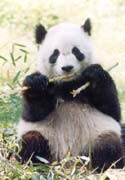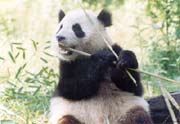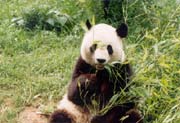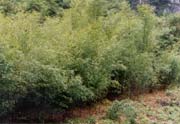|
 Giant pandas are carnivores, but 99% of their food comes from more than 20 kinds of bamboos that grow in the high mountains and the deep valleys of China. With the changes of the seasons, the kinds of the bamboos and the diet of the giant pandas are different. They like bamboo shoots best. From spring to summer, they like to live on the bamboo shoots of the Qiong bamboo (Q.tunidinoda Hsueh et Yi), some bamboos of the madake bamboo category, the wood bamboos in Bashan, the walking stick bamboos, the Chaohua arrow bamboos (Fargesia scabrida Yi), the Huaxi arrow bamboos and the big arrow bamboos. The bamboo shoots are the new trunks of the bamboos that have no branches or leaves and grow from the underground bamboo roots. The bamboo is very small and tender, and the water content is abundant. The nutritional components include: the raw fat is 1.27%, the raw fiber is 33.62%, the crude protein is 10.32%, and the general quantity of sugar is 26.15%. The bamboo shoots are small and tender and they are succulent which taste good and therefore are easy to be digested and absorbed and they are dainty dishes for giant pandas. From spring to autumn every year, in order to eat the different kinds of bamboos and bamboo shoots of different heights above sea level, the giant pandas will look for food from the middle mountains to the high mountains, which is called "the chasing of the bamboo shoots". Giant pandas are carnivores, but 99% of their food comes from more than 20 kinds of bamboos that grow in the high mountains and the deep valleys of China. With the changes of the seasons, the kinds of the bamboos and the diet of the giant pandas are different. They like bamboo shoots best. From spring to summer, they like to live on the bamboo shoots of the Qiong bamboo (Q.tunidinoda Hsueh et Yi), some bamboos of the madake bamboo category, the wood bamboos in Bashan, the walking stick bamboos, the Chaohua arrow bamboos (Fargesia scabrida Yi), the Huaxi arrow bamboos and the big arrow bamboos. The bamboo shoots are the new trunks of the bamboos that have no branches or leaves and grow from the underground bamboo roots. The bamboo is very small and tender, and the water content is abundant. The nutritional components include: the raw fat is 1.27%, the raw fiber is 33.62%, the crude protein is 10.32%, and the general quantity of sugar is 26.15%. The bamboo shoots are small and tender and they are succulent which taste good and therefore are easy to be digested and absorbed and they are dainty dishes for giant pandas. From spring to autumn every year, in order to eat the different kinds of bamboos and bamboo shoots of different heights above sea level, the giant pandas will look for food from the middle mountains to the high mountains, which is called "the chasing of the bamboo shoots".
 
As for a bamboo as a whole, the content of the nutrition components increases gradually from the bottom of the trunk to the top. Taking the cold arrow bamboos (Bashania faberi Yi) for example, the raw fat of the bamboo pole is  0.59%, and that of the bamboo branches is 3.37%; the crude protein of the bamboo pole is 4.20%, and that of the bamboo leaves is 19.44%; the raw fiber of the bamboo pole is 46.66%, and that of the bamboo leaves is 24.27%. So, although giant pandas love bamboo shoots, but it is reasonable for them to live on bamboo leaves and the upper bamboo poles of the young first-year bamboos. 0.59%, and that of the bamboo branches is 3.37%; the crude protein of the bamboo pole is 4.20%, and that of the bamboo leaves is 19.44%; the raw fiber of the bamboo pole is 46.66%, and that of the bamboo leaves is 24.27%. So, although giant pandas love bamboo shoots, but it is reasonable for them to live on bamboo leaves and the upper bamboo poles of the young first-year bamboos.
Giant pandas living in the wild will look for other plants as their food occasionally, such as beardless wheat, corns, equisetums, green thatch grass, multi-hole gill fungus, wild angelicas, notoperygium roots, the barks of the young firs, and some other plants. They may even act in a way that does not accord with normal behavior in that they will pick up the dead bodies of the animals and eat them or catch the small animals as their food.
Unique Nature
Special Life and Schedule
|